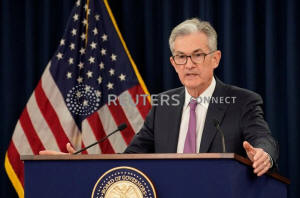Fed chief likely to focus on trade-inspired policy shift in testimony
 Send a link to a friend
Send a link to a friend
 [July 10, 2019]
By Howard Schneider [July 10, 2019]
By Howard Schneider
WASHINGTON (Reuters) - The U.S. Federal
Reserve over the course of its 105-year history has changed monetary
policy in reaction to property crashes, war, financial bubbles and
policymakers' gut instincts about where the economy was heading.
But the U.S. central bank is now laying the groundwork for its first
policy shift triggered by tweets, as Fed officials grapple with how the
ground shifted on May 30 when U.S. President Donald Trump threatened on
Twitter to impose new import tariffs on Mexico if it did not agree to
curb the flow of migrants across the U.S.-Mexico border.
The U.S. economy did not change much in the days that followed. But
Trump's statements spooked financial markets so decisively, and the
threats to the global economy became so palpable, that an interest rate
cut of at least 25 basis points has been baked in for the Fed's July
30-31 policy meeting, a message Fed Chairman Jerome Powell is expected
to reinforce when he testifies before a congressional committee on
Wednesday.
"The Fed has never disappointed a market with such strong expectations
of action," Joseph Lavorgna, chief economist for the Americas at Natixis,
wrote in a recent analysis.

With investors in contracts linked to the Fed's targeted overnight
lending rate putting the probability of a rate reduction at close to 100
percent, "it would be unprecedented for the Fed to not cut," Lavorgna
wrote.
Powell is scheduled to appear before the U.S. House of Representatives
Financial Services Committee at 10 a.m. EDT (1400 GMT) as part of his
semi-annual monetary policy testimony to Congress.
Four hours later, the Fed is due to release the minutes from its last
policy meeting, when officials edged toward a rate cut as early as this
month.
The minutes should show the extent to which the thinking at the central
bank shifted in the days following Trump's Mexico tariff threat, and how
the discussion was shaped by other concerns including weak inflation.
Powell will return to Congress on Thursday to testify before the Senate
Banking Committee.
Though U.S. economic growth remains largely on track and the jobs report
for June showed continued strong hiring, the events of May changed U.S.
trade policy from something of a sideshow in the Fed's view to a central
concern.
Earlier rounds of U.S. tariffs on trading partners including China had
been dismissed as of little macroeconomic importance, with the Fed in
early May still anticipating its policy rate would remain unchanged in a
range of 2.25% to 2.50% for the rest of the year.
By contrast, the higher tariffs announced against China in early May, a
rising sense the world's two largest economies might not be able to make
a deal, and the tariff threat against Mexico all added to the growing
feeling that protectionism and higher tariffs were here to stay - at
some cost to investment and growth.
[to top of second column]
|

Federal Reserve Chairman Jerome Powell holds a news conference
following a two-day Federal Open Market Committee meeting in
Washington, U.S., June 19, 2019. REUTERS/Kevin Lamarque

'CAUTIOUS LINE'
The case for lowering borrowing costs isn't fully decided. Reducing
rates at this point would be similar to the Fed's efforts in the
mid-1990s to nurse along a lengthy recovery rather than respond to a
looming downturn, and "there's no immediate need to move,"
Philadelphia Fed President Patrick Harker said on Tuesday.
But Trump's tweets about Mexico had a particularly unsettling
impact, touching off enough volatility and doubt about the future
that it pushed the Fed toward the very rate cuts Trump has demanded
for other reasons.
As Trump tied the threatened tariffs, which would have hit one of
the world's most integrated supply chains, to non-economic demands
about immigration, investors over two days knocked about a quarter
of a percentage point from the federal funds rate expected at the
end of 2019.
That added a full additional rate cut to the one investors already
had expected, and added market pressure to the Fed's growing list of
concerns.
At the Fed's last policy meeting in mid-June, eight of the 17
policymakers saw the need for at least one rate cut by year's end,
and Powell told reporters afterwards that many others were leaning
in that direction. The minutes may show how strong that bias has
become.
In the Fed's monetary policy report issued last week ahead of
Powell's testimony, the trade war received its own analysis, a sign
of the attention it is getting within the central bank.
Fed staff concluded the rise in world tariffs had a likely
"material" impact on the slowdown in global trade last year, and
that "uncertainty surrounding trade policy could be leading firms to
delay investment decisions and reduce capital expenditures."
Though the threatened tariffs on Mexico never materialized and China
and the United States have agreed to resume talks to reach a trade
deal, that "did little to alleviate the uncertainty that Fed
officials believe is contributing to cooling momentum in global
trade and domestic capex plans," Deutsche Bank's U.S. economics team
wrote this week.

"We anticipate that Powell will stick with a cautious line," they
wrote.
(Reporting by Howard Schneider; Editing by Paul Simao)
[© 2019 Thomson Reuters. All rights
reserved.]
Copyright 2019 Reuters. All rights reserved. This material may not be published,
broadcast, rewritten or redistributed.
Thompson Reuters is solely responsible for this content. |